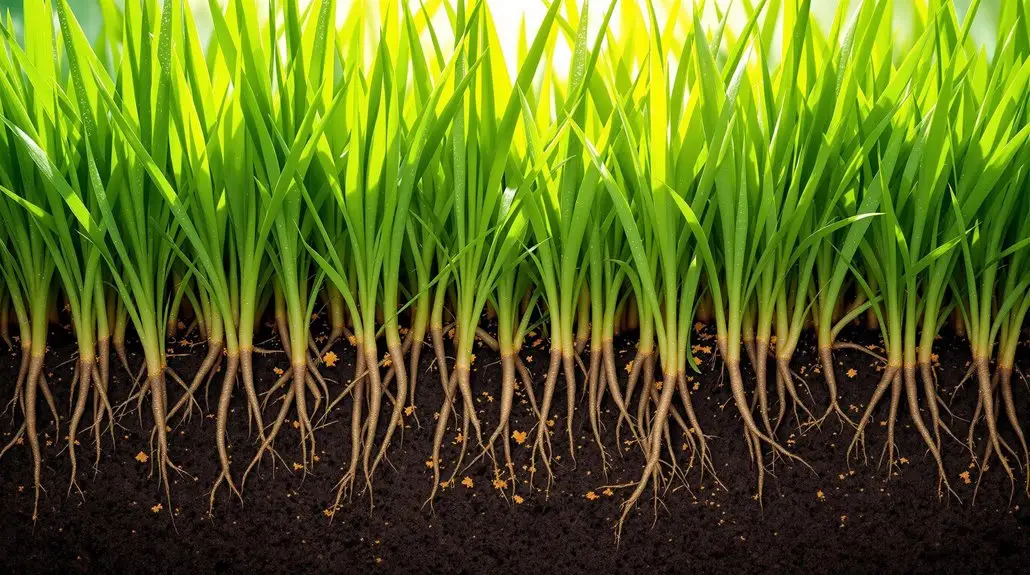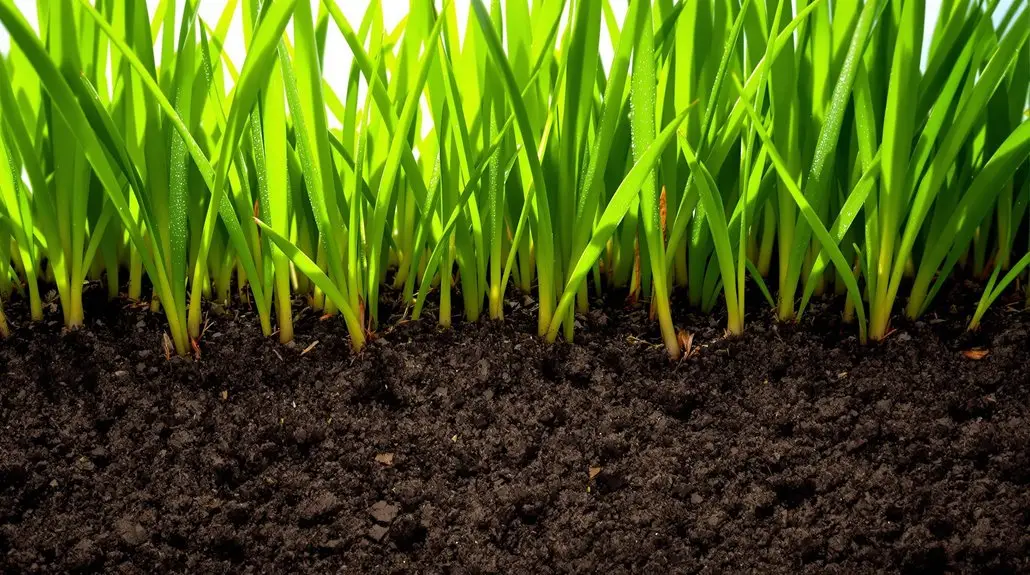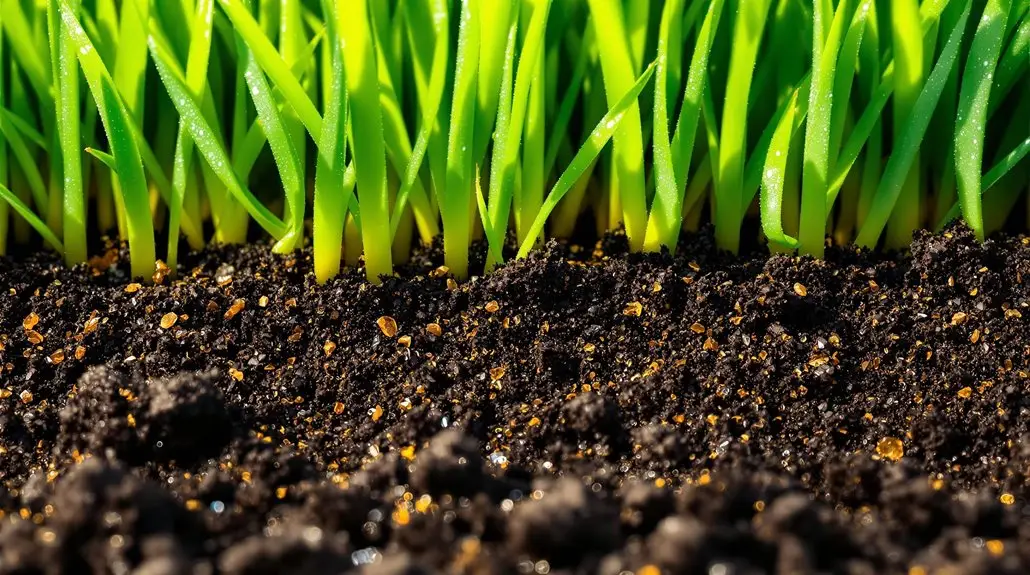Fulvic acids enhance St. Augustine grass in South Florida by improving soil structure, promoting deep root growth, and facilitating nutrient absorption.
They enhance water retention and aeration, which supports healthy root systems. Additionally, these acids stimulate microbial activity, enriching soil with essential nutrients and fostering disease resistance.
By improving nutrient chelation, they increase micronutrient availability, enabling robust growth. Understanding these benefits can further assist in optimizing lawn care practices for healthier turf.
Unlock the Secrets to Lush Lawns!
Ready to transform your St. Augustine grass into a thriving, vibrant landscape?
Discover the power of fulvic acids in your lawn care routine. For expert guidance and holistic solutions, reach out to NaturePest Holistic Pest Control today, and watch your South Florida lawn flourish!
Key Insights
- Fulvic acids enhance nutrient absorption, improving the availability of essential micronutrients for St. Augustine grass in nutrient-poor sandy soils.
- They stimulate microbial activity, enriching the soil with nutrients and promoting a balanced ecosystem that supports grass health.
- Fulvic acids improve soil structure and aeration, enhancing water retention and root growth during South Florida’s heat stress.
- They enhance disease resistance, protecting St. Augustine grass from common issues like large patch and brown patch.
- Regular application of fulvic acids boosts overall plant vitality, making St. Augustine grass more resilient to environmental stresses.
The Role of Fulvic Acid in Enhancing Soil Structure

While the health of St Augustine grass largely depends on the quality of its soil, the role of fulvic acid in enhancing soil structure cannot be overstated. Fulvic acid promotes soil aggregation, which improves water infiltration and aeration, making it easier for roots to grow. It also enhances water retention, addressing moisture balance, particularly during periods of heat stress. By creating a more porous and aerated environment, fulvic acid contributes to ideal root health. Additionally, it stimulates microbial activity, enriching the soil with essential nutrients while facilitating organic matter decomposition. The improvements in soil physiochemical properties, such as cation exchange capacity, further enhance nutrient availability, ensuring that your St Augustine grass receives the necessary elements for robust growth. Furthermore, the presence of enhanced microbial activity from fulvic acid plays a crucial role in breaking down organic matter, making nutrients more accessible to the grass. This multitool for nourishing plants not only supports vigorous growth but also helps plants become more resilient against environmental stresses. Moreover, fulvic acid’s ability to act as a natural chelator allows it to bind with minerals, significantly increasing their bioavailability for the grass. The better nutrient uptake facilitated by fulvic acid’s chelating properties ensures that vital minerals are readily available for optimal grass health.
Promoting Deep Root Growth in St. Augustine Grass

Promoting deep root growth in St. Augustine grass is vital for its overall health and resilience. To achieve this, implement a deep watering strategy, allowing the soil to absorb moisture thoroughly but less frequently. Maintaining a mowing height between 3 and 4 inches encourages deeper root systems. Ensuring proper soil pH between 5.0 and 7.5 is essential for ideal growth. Additionally, an effective irrigation schedule during establishment prevents drying out, while avoiding overwatering protects against fungal diseases that can hinder root development. Regular nutrition and fertilization practices also play a crucial role in supporting robust root systems. Furthermore, St. Augustine grass is known for its saltwater resistance, making it an excellent choice for coastal regions in South Florida. Proper fertilization enhances the grass’s ability to withstand environmental stresses, contributing to deeper roots and a healthier lawn. For optimal establishment, consider sodding as it provides an instant lawn and reduces competition from weeds. Furthermore, balanced nutrient delivery ensures that St. Augustine grass receives the essential elements it needs for strong root development.
| Factor | Importance |
|---|---|
| Watering Strategy | Encourages deep root growth |
| Mowing Height | Improves turf appearance |
| Soil pH | Essential for grass health |
| Irrigation Schedule | Maintains ideal moisture levels |
| Overwatering Risks | Prevents fungal diseases |
Improving Nutrient Absorption and Uptake

Improving nutrient absorption and uptake in St. Augustine grass involves understanding the vital roles of nutrient chelation, enhanced soil microbial activity, and efficient nutrient utilization. By binding with essential minerals, fulvic acid makes nutrients more accessible for uptake, while stimulating beneficial microbes guarantees that these nutrients are effectively cycled within the soil. This synergy not only enhances the grass’s growth and resilience but also promotes a more sustainable approach to lawn care in nutrient-poor environments. Additionally, the application of Humic Elite PG® can further improve nutrient availability and uptake for optimal grass health. Integrating humic acid into the soil can provide a holistic boost to nutrient levels, further supporting the health of St. Augustine grass.
Nutrient Chelation Process
Understanding the nutrient chelation process is fundamental for enhancing the absorption and uptake of critical nutrients in St. Augustine grass. Fulvic acids play an important role by forming stable complexes with metal ions, greatly increasing nutrient solubility and availability. These polydentate ligands solubilize nutrients trapped in mineral forms, allowing plant roots to access them more effectively. Additionally, fulvic acids can modify soil pH, further influencing nutrient availability. Here are some key aspects of the nutrient chelation process:
- Fulvic acids bind essential micronutrients like iron and zinc.
- They enhance the transport of nutrients to plant roots.
- Chelation improves nutrient mobility within the soil.
- Stable complexes prevent nutrient precipitation.
- Ideal conditions for chelation vary based on pH and temperature. Furthermore, fulvic acid is a natural chelating agent that improves nutrient uptake efficiency and overall plant health, making them crucial for increasing micronutrient availability in the soil. This process is facilitated by their high cation exchange capacity, which allows for effective complexation with various nutrients. Additionally, fulvic acid acts as a natural chelator in soil environments, enhancing the overall nutrient availability for St. Augustine grass.
Enhanced Soil Microbial Activity
While fulvic acid‘s role in enhancing soil microbial activity is often understated, it greatly contributes to the overall health and nutrient absorption capabilities of St. Augustine grass. By acting as a substrate and energy source, fulvic acid stimulates beneficial soil bacteria and fungi, increasing their populations and encouraging the decomposition of organic matter. This process releases essential nutrients for the grass’s root absorption. Additionally, a diverse microbial community fosters a balanced ecosystem that reduces harmful pathogens and promotes turf resilience. Key bacteria, such as Bacillus and Pseudomonas species, improve nitrogen fixation and phosphorus solubilization, while enhanced microbial activity accelerates organic matter breakdown, considerably improving soil fertility, particularly in South Florida’s sandy soils, ultimately benefiting your lawn’s growth and health. Furthermore, the incorporation of Lawn Dethatcher’s microbial activity enhances the effectiveness of fulvic acids in improving soil conditions. Additionally, ByoSpxtrum’s proprietary ingredient mix boosts beneficial soil microbes, further enhancing nutrient availability for optimal grass health. The integration of bio-stimulants into turf management practices can significantly enhance nutrient absorption efficiency and overall turf sustainability.
Efficient Nutrient Utilization
Fulvic acid greatly enhances the nutrient absorption capabilities of St. Augustine grass, particularly in the nutrient-deficient soils of South Florida. By acting as a chelating agent, it binds soil minerals, transforming them into more absorbable forms, ensuring essential nutrients remain accessible for sustained uptake. This process prevents nutrient leaching and encourages stronger root development, which further improves nutrient utilization.
- Increases absorption of macronutrients and micronutrients.
- Enhances enzymatic activities for better nutrient assimilation.
- Stimulates root growth, improving water and nutrient access.
- Improves soil chemistry, facilitating nutrient mobility.
- Reduces the need for frequent fertilization through effective nutrient cycling.
These factors work together to promote healthier, more resilient St. Augustine grass, enhancing overall turf health.
Strengthening Immune System and Disease Resistance
To effectively strengthen the immune system of St. Augustine grass, applying fulvic acids can play a key role. These organic compounds enhance nutrient uptake, making essential micronutrients more available, which is essential for maintaining a healthy immune response. Research indicates that fulvic acids induce disease resistance, protecting your grass from common issues like large patch and brown patch. Additionally, they promote a balanced microbial community in the soil, important for preventing disease outbreaks. By improving nutrient availability and boosting the grass’s defenses against pests, fulvic acids greatly contribute to overall plant health. Furthermore, CitraBlue’s disease resistance allows it to thrive even when disease pressures are high. Ultimately, a well-supported immune system allows St. Augustine grass to thrive in South Florida’s challenging climate, ensuring a lush and resilient lawn. Furthermore, addressing soil conditions such as compaction and poor drainage can further enhance the effectiveness of fulvic acids in promoting a healthy lawn. The ability of St. Augustine grass to tolerate heat and humidity further improves its resilience when fulvic acids are applied.
Enhancing Environmental Stress Tolerance
Strengthening the immune system of St. Augustine grass is vital for enhancing its environmental stress tolerance. Fulvic acid plays a significant role by improving soil conditions and boosting physiological responses in the grass.
- It enhances soil water retention and aeration, facilitating root respiration and moisture access.
- Fulvic acid’s antioxidant properties neutralize reactive oxygen species, reducing oxidative stress.
- It increases nutrient availability and uptake, ensuring the grass receives essential micro- and macronutrients.
- Root growth becomes more robust, allowing for better anchorage and resilience against drought.
- Improved microbial activity contributes to soil health, enabling better nutrient cycling and moisture retention. Organic biostimulants can further enhance these effects, promoting a healthier and more resilient lawn.
Together, these factors help St. Augustine grass thrive even under adverse environmental conditions typical of South Florida.
Application Methods for Fulvic Acid in Lawn Care
When applying fulvic acid to your St. Augustine grass, you can choose between foliar spray techniques and soil treatment methods, each offering distinct advantages. Foliar applications allow for quick absorption through the leaves, while soil treatments guarantee that the nutrients penetrate deeply into the root zone. Understanding these application methods will help you enhance the overall health and energy of your lawn effectively. Regular use of fulvic acid can boost overall plant vitality and resilience against environmental stressors. Additionally, incorporating humic acid into your lawn care routine can further enhance nutrient availability and improve soil structure. Increased nutrient absorption efficiency is another benefit of using these products, which can lead to better growth and color in your St. Augustine grass.
Foliar Spray Techniques
Foliar spray techniques for applying fulvic acid in lawn care present an effective method for enhancing the health and vigor of St. Augustine grass. To achieve ideal results, follow these guidelines:
- Apply sprays during cooler parts of the day, like early morning or late evening, to prevent leaf burn.
- Dilute fulvic acid as per the manufacturer’s instructions to avoid phytotoxicity. Additionally, foliar sprays enable rapid nutrient uptake that can significantly benefit plant health. Furthermore, incorporating nanoscale liquid foliar sprays can enhance nutrient absorption and support overall turf vigor. It is important to note that liquid fertilizers can increase grass growth rate by up to 50%, making them a valuable addition to your lawn care routine.
- Confirm you cover the entire leaf surface, including the underside, with a light mist for better absorption. Utilizing a sprayer that produces a finer mist will enhance coverage, particularly when considering that larger droplet tips are best for products requiring thorough water-in application.
- Schedule applications every 3-4 weeks during periods of active growth for maximum benefit. Additionally, it is important to spray only in still air to avoid drift and ensure effective application.
Soil Treatment Methods
Applying fulvic acid as a soil treatment method considerably enhances the overall health of St. Augustine grass by improving soil structure and nutrient availability. To achieve ideal results, consider the following application methods:
| Method | Description |
|---|---|
| Timing | Apply every 4–6 weeks during the growing season. |
| Dosage | Use 1–2 ounces per 1,000 square feet. |
| Integration | Combine with fertilizers for better nutrient uptake. |
| Monitoring | Conduct periodic soil tests to assess effectiveness. |
These techniques guarantee that the fulvic acid works effectively to stimulate beneficial microbial activity, release existing nutrients, and promote healthier grass. By adhering to proper application guidelines, you can maximize the benefits of fulvic acid for your lawn care routine. Additionally, fulvic acid acts as a natural chelator of nutrients, enhancing their availability to plants and supporting robust growth. Incorporating humic acid options alongside fulvic acid can further improve soil health and nutrient retention, leading to a thriving lawn.
Integrating Fulvic Acid With Other Organic Practices
Integrating fulvic acid with other organic practices considerably enhances the overall health of St. Augustine grass, particularly in South Florida’s sandy soils. By improving soil structure and promoting microbial activity, fulvic acid supports a robust ecosystem that benefits your lawn. Here are some key aspects to take into account:
- Enhances soil aggregate formation, improving water infiltration and aeration.
- Stimulates beneficial microbes, enriching soil nutrient availability.
- Works synergistically with organic fertilizers like Milorganite to release nutrients. Additionally, higher nitrogen needs in sandy soils can be effectively addressed with fulvic acid applications.
- Fosters deeper root systems, enhancing drought tolerance and disease resistance. Additionally, healthy soil is essential for strong grass growth in South Florida’s challenging conditions.
- Buffers soil pH and improves nutrient retention, creating an ideal growth environment.
Frequently Asked Questions
How Often Should Fulvic Acid Be Applied to St. Augustine Grass?
You should apply fulvic acid treatments to St. Augustine grass monthly during the growing season for ideal results. This frequency maximizes nutrient uptake and enhances soil structure. Be sure to water the area after application to activate the amendments effectively. Adhering to the recommended dosage—typically around 6 ounces per 1,000 square feet—ensures cost-effectiveness and sustainability, while avoiding excessive application, which can waste the product without damaging the turf.
Can Fulvic Acid Harm My Lawn if Over-Applied?
Over-applying fulvic acid typically won’t harm your lawn, but it’s unnecessary and can be wasteful. While this organic compound enhances soil health and nutrient availability, excessive application doesn’t yield additional benefits. Instead, it’s crucial to focus on proper application methods and consider soil testing before use. By doing so, you’ll guarantee that your lawn receives the right balance of nutrients, promoting robust growth without the risks associated with over-application.
Is Fulvic Acid Safe for Pets and Children?
Fulvic acid is generally considered secure for pets and children when used appropriately, but caution is essential. In pets, it can support nutrient absorption and overall health, though consulting a veterinarian for dosage is advisable. For children, limited data exists on long-term effects, making medical supervision vital. Potential side effects, like diarrhea or headaches, may occur, so it’s wise to avoid use in young children unless under professional guidance. Always prioritize security.
What Are the Signs That My Grass Needs Fulvic Acid?
If you notice yellowing blades, soil compaction, or shallow root systems, your grass might need fulvic acid. Additionally, signs of heat stress, like browning or wilting, indicate possible benefits from fulvic acid’s properties. Poor soil structure, particularly in clay-heavy areas, can also signal a need for this treatment. Regular observation of these symptoms helps you identify nutrient deficiencies and soil health issues, guiding your decisions on necessary interventions for ideal grass growth.
Where Can I Purchase Fulvic Acid Products for Lawn Care?
You can purchase fulvic acid products for lawn care at various locations. Retail giants like Walmart offer brands such as Simple Lawn Solutions online, while local garden centers often stock organic options. Additionally, specialty stores focusing on natural lawn products may carry these products. Online retailers provide a wide selection, including offerings from Yard Mastery and Southland Organics. Manufacturer websites are also a reliable source for direct purchases of fulvic acid formulations.
Final Thoughts
Incorporating fulvic acid into your lawn care routine can greatly enhance the health and vigor of St. Augustine grass in South Florida. By improving soil structure, promoting deep root growth, and increasing nutrient absorption, fulvic acid serves as an essential component in fostering a resilient lawn. As you consider the potential benefits, can you imagine the transformation of your grass into a lush, thriving landscape? Embracing this organic approach not only strengthens your lawn but also contributes to a sustainable environment.

